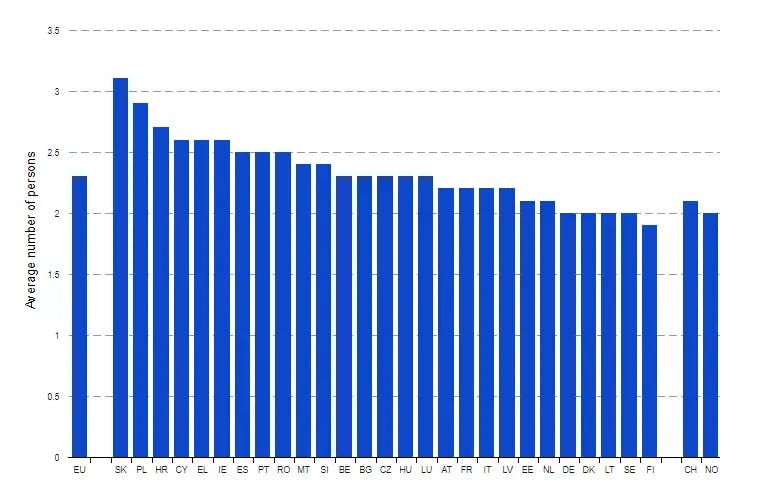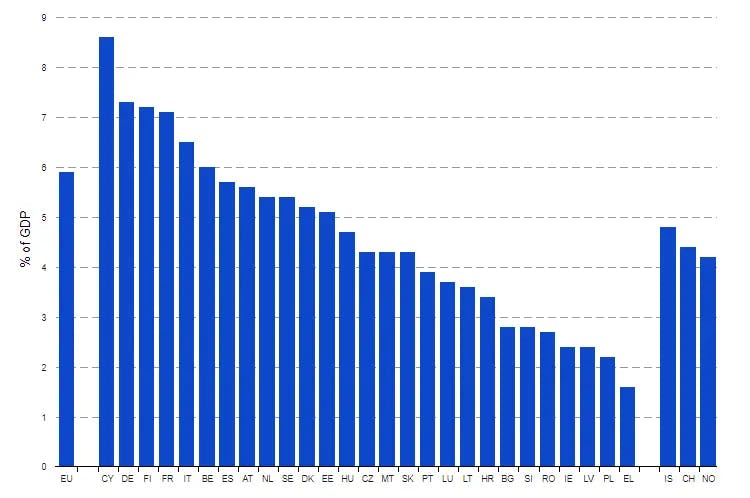Luxembourgers live in better housing conditions than the average European

The European Union is very diverse. This is true not only of the political and economic characteristics of each country but also of the conditions under which its people live. And although the average indicators are quite good, a closer look reveals sometimes surprising details. This is the subject of the latest Eurostat study.
Own home
On average in the EU, 69% of people live in houses and apartments they own. Only a third rent their home. This is an impressive figure, even when looking at the distribution by country.
Looking at Luxembourg, it is worth noting that 72.4% of its inhabitants own their homes. Interesting data given the large number of expats, the average cost per square meter and the overall cost of living.
However, even with these figures, the Grand Duchy is in the middle of the ranking. Romania comes in first, with 94% of the population owning their own home. This is followed by Slovakia and Croatia with 93% and 91% respectively. These data are quite natural, since all three countries can hardly be considered leaders in terms of interest among migrants. The majority chooses Western Europe and dilutes the percentage of owners.
In Germany, for example, less than half of the population owns an apartment or a house: only 46.7%.

It is also worth noting that private houses and apartments are equal in the EU: 52% and 47.5% respectively. Another 0.5% are in other forms of housing — floating houses, caravans, etc.
Size of the house
The study deviated from the standard square meters per person and calculated a slightly different ratio.
The European average is 1.6 rooms per person. Luxembourg, by the way, ranks second in this parameter with 2.2 rooms per inhabitant. Only Malta has a higher ratio, with 2.3 rooms per person. The least space is available in Slovakia, Romania and Poland — just over 1 room per tenant.
The situation is different for houses. Here it is not the number of rooms that is calculated, but the total number of tenants. The lower the indicator, the better.
Luxembourg does not have such a clear advantage here. On average, 2.3 persons live in households in the Grand Duchy. This is in line with the EU average. To be fair, the best indicator is in Finland, where the difference is only 0.4 persons per house:

Overcrowded homes
Another interesting indicator to consider. It should be noted that Luxembourg has not yet been affected by the problem of overcrowding. According to official data, less than 5% of the country's population lived in overcrowded houses, in empty houses - just under 59%.
In simple terms, an overcrowded house is a dwelling that does not have enough free space for the needs of the people who live in it. Conversely, an empty house has too much space for its occupants.
In general, the problem of lack of space affected only 17% of Europeans, which is also quite low.
Resource allocation
Another aspect that is still alarming, despite the low figures, is the ability to heat homes. Fortunately, Luxembourg fared well, even during the energy crisis of 2022. Only 2.1% of the population was unable to maintain a comfortable indoor temperature at all times. Compared to Bulgaria (22.5%), Cyprus (19.2%), and Greece (18.7%), this is an excellent result.
A rather mild winter in Western Europe and active government support contributed to this.
If we take a step back from saving and rational use of heat and electricity and look at the overall availability of some services, the data is shocking.
For example, 1.5% of all European households had no toilet, shower, or bath. The biggest problem was in Romania — 21.2% of all households did not have access to any form of sanitation. Luxembourg, Germany, Sweden, the Netherlands, and Malta had no such problem at all: 0%.
Cost of housing
It would be strange to write only good things and ignore the indicator that the Grand Duchy certainly cannot boast. According to the latest data, from 2010 to 2022, the cost of buying real estate in Luxembourg has more than doubled — by 135%. Only Hungary (+172%) and Estonia (+192%) are ahead.
The cost of utilities has also risen sharply over the past decade. In 2010, Luxembourgers had to pay 55% more than the EU average for water, gas, and electricity; by 2022, this figure will have risen to 86%.
Government subsidies and additional support measures should be taken into account. This is one of the reasons why prices have not skyrocketed to 200% of the Alliance average, as they have in Ireland and Switzerland.
Construction
Another problem of the Grand Duchy. Between 2022 and 2023, the industry was hit by a crisis from which it never fully recovered. The number of construction projects declined and the prices of finished homes rose due to geopolitical issues, the cost of materials, and general logistical failures.

Investments also vary widely. For example, Cyprus invests 8.6% of its GDP in this sector, while Luxembourg invests "only" 3.7%. This distribution seems a bit unfair and illogical. However, we must not forget an important detail — the total GDP of the countries. Therefore, the Grand Duchy's 3.7% may end up being more than Malta's 4.3%.





